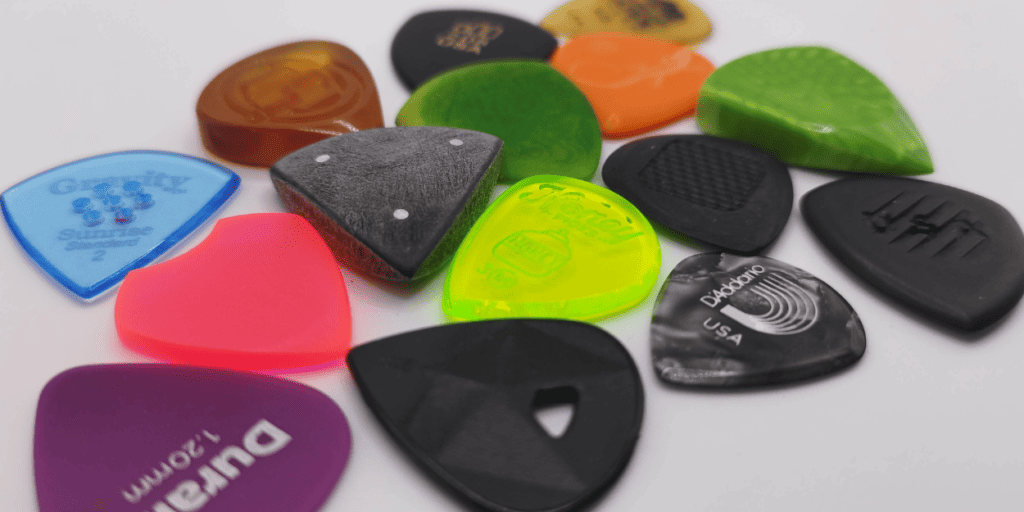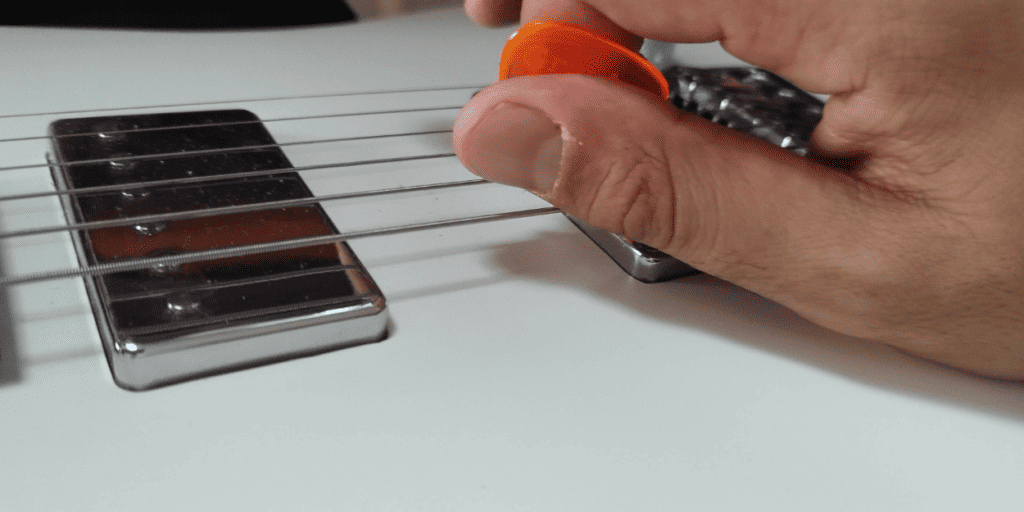Imagine listening to a heavy metal track or a rock anthem. The guitar emits high-pitched squeals that are almost ethereal. These are pinch harmonics, a technique that can give your music a distinctive sonic texture.
An example of a pinch harmonic is in the song Laid to Rest by Lamb of God, and it appears right in the beginning.
From the fundamental mechanics to more complex variations, today we will cover everything you need to know about mastering this technique.
Table of Contents
Things You’ll Need
It is essential to arm yourself with the appropriate tools before you delve into the world of pinch harmonics. Imagine a chef gathering all the necessary ingredients before whipping up a storm in the kitchen. Each tool you use, from the type of guitar pick you use to the settings on the amplifier, is essential to your success. So, let us ensure you are ready to hit those high-pitched squeals with everything you need!
The Right Pick
The pick you use can significantly impact your ability to make pinch harmonics. Better control and easier squealing are possible with thicker picks of materials like Ultem (Ultex), Acrylic, or Delrin (Acetal, Tortex).
I prefer using a relatively small pick, about the size of a Jazz III, and anyway, not larger than a standard-shaped pick, at least not when you are just starting with pinch harmonics. This is, of course, not mandatory, but a personal preference.

High Gain Amplification
Making your pinch harmonics stand out requires an amplifier with a decent amount of gain, either through the gain channel of the amp or through an overdrive or distortion pedals.
I prefer to go the pedal route just because it gives you more control over the tone of the squeal.
The Right Type of Guitar
Well, not exactly the type of guitar, but the type of pickups. This surprised me, too, when I first found out about it. Compared to single-coil pickups, humbuckers produce clearer, louder, and fuller harmonics.
How to do Pinch Harmonics?
Now that everything is prepared, let’s get to the fun part. Take your guitar and turn the amp up. Are you excited? Me too! Let’s start
Step 1: Pick a Note
To begin with, pick a note on the low E or A strings. Although the method applies to all strings, thicker strings make learning easier. This is because thicker strings vibrate with more energy, making the next step less likely to kill the note.
The harmonics may sound wrong if your guitar requires tuning.
It may sound simple, to just “pick a note” but each note has different points of the strings from which the pinch harmonic can emerge, which is based of the natural harmonics on the guitar.
Step 2: The Pinch
Many guides say to allow your thumb’s edge to lightly touch the string after picking it, but I think this is extremely confusing.
I’d describe this “move” as a slight twist to the thumb after to pick so the side of the thumb hits the string you just pick rather than its tip.

The harmonic results from this “pinching” motion. The key is to complete this process quickly and accurately, and to make it sound like the note has one single attack.
Step 3: Add Some Vibrato
After creating the harmonic, add vibrato by moving your fretting hand along the string. The harmonic will sound more musical and have more sustain as a result. Depending on the musical context, the vibrato technique can be as simple or as complex as you like.
Common Mistakes and How to Avoid Them
Nobody becomes an expert at pinch harmonics overnight; along the way, there will undoubtedly be some setbacks. But do not worry; it is all just a part of learning! In this section, we will discuss some typical pitfalls that guitarists frequently encounter and, more importantly, how to avoid them. Consider this to be your manual for troubleshooting pinch harmonics.
Too Much Thumb
One common error is letting your thumb touch the string too much, which can silence the harmonic. Often, using less force is preferable.
Wrong Pick Angle
Additionally, how you hold the pick can impact your success. Try out various perspectives to see which suits you the best. Some guitarists say the best results come from holding the pick at a 45-degree angle to the string.
Inconsistent Technique
The pinching technique’s inconsistency is another error. To create harmonics that are audible and clear, consistency is essential. Practice slowly and deliberately to establish a more reliable technique.

Advanced Techniques
Now that you have mastered the fundamentals and avoided common mistakes, what comes next? It is time to level up with some sophisticated methods! Here, you can express your creativity and give your playing a special flair. We will look at methods to make your guitar sing, scream, and everything in between, from tapped harmonics to whammy bar dives.
Tapped Harmonics
This involves picking the string while tapping it at a harmonic node with your fretting hand. For more intricate musical phrases, this generates a different type of harmonic.
Whammy Bar Dive
If you have a whammy bar, add a dive bomb to your pinch harmonic for a dramatic, attention-grabbing effect. This entails striking the harmonic and sharply lowering the pitch with the whammy bar.
Slides and Bends
For a more dynamic and expressive sound, you can slide into or out of a pinch harmonic or bend the string after hitting the harmonic.
Tips for Practicing Pinch Harmonics
Although repetition makes perfect, how you practice is just as important as how frequently. This section will provide some advice to help you get the most out of your practice sessions. These pointers will make it easier for you to improve your pinch harmonic abilities, whether you pinch harmonic on the weekends or every day.
- Take it Slow: Learning pinch harmonics requires practice. Before increasing the speed, start slowly to perfect the technique.
- Find Each Note’s Sweetspots: The squeal shouldn’t be a random frequency shouted out of your amp. Make sure it fits.
- Record yourself: This lets you listen back and determine what you need to work on. When you are not in the thick of a game, it is frequently simpler to hear what you are doing right or wrong.
Conclusion
It can be satisfying to master pinch harmonics. It gives your guitar playing a new dimension and the freedom to express yourself in ways you might not have imagined. Even though it might initially seem difficult, with the right equipment and persistent practice, you will soon be screaming your guitar. Therefore, do not wait; pick up your guitar and begin honing your pinch harmonics immediately. You will dazzle both your audience and yourself.